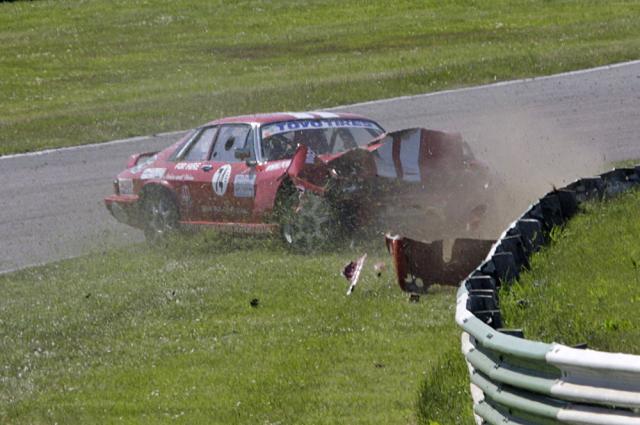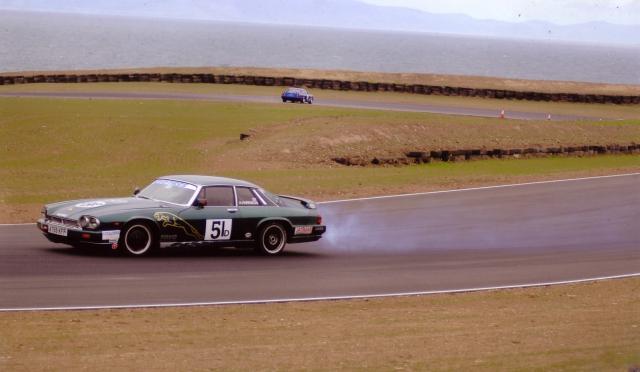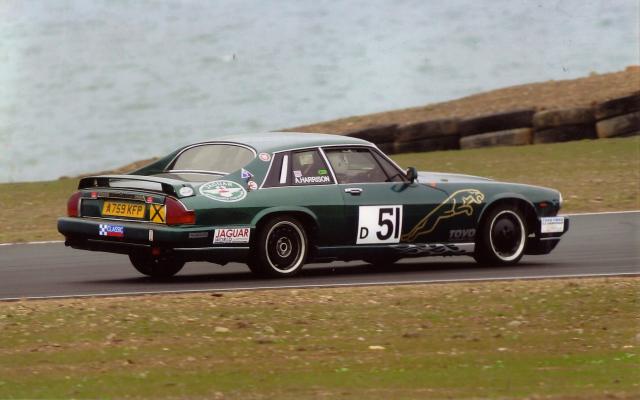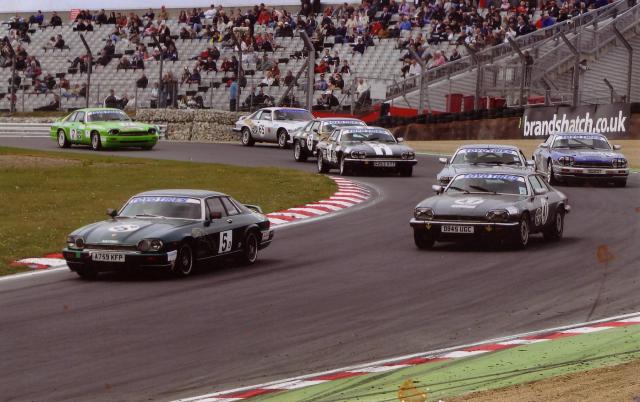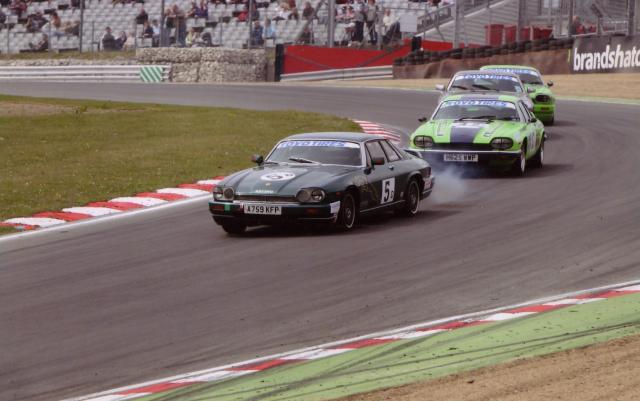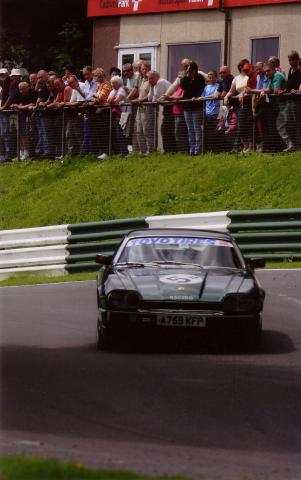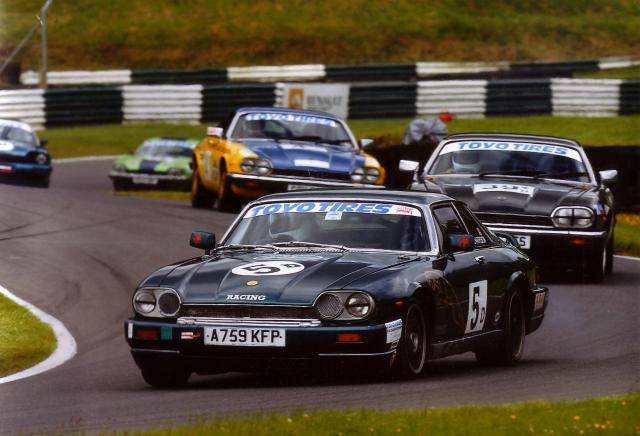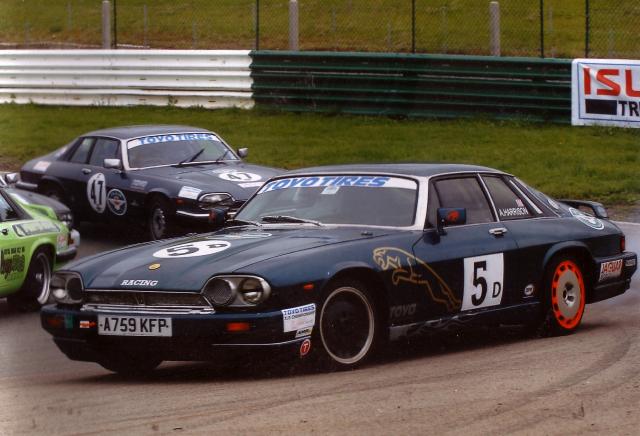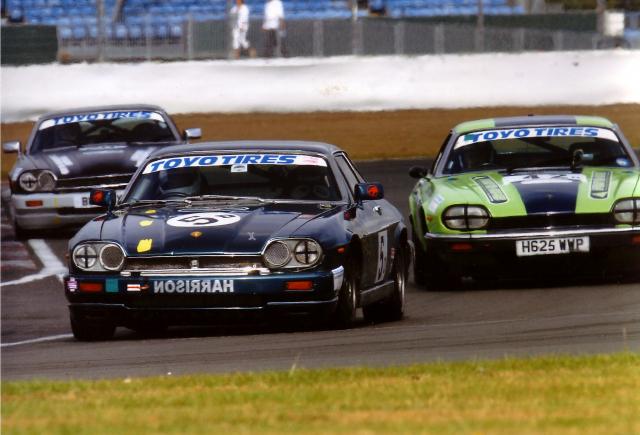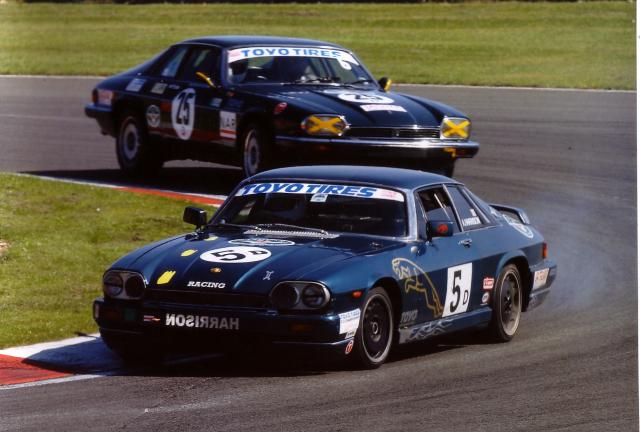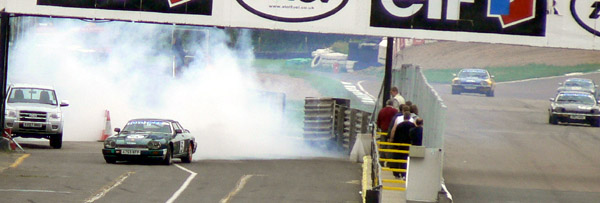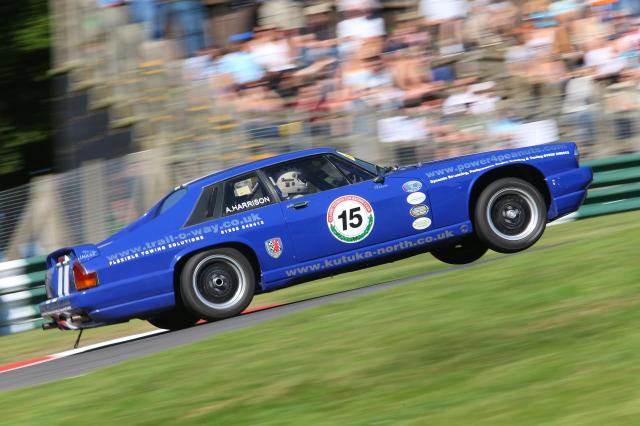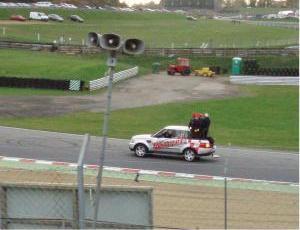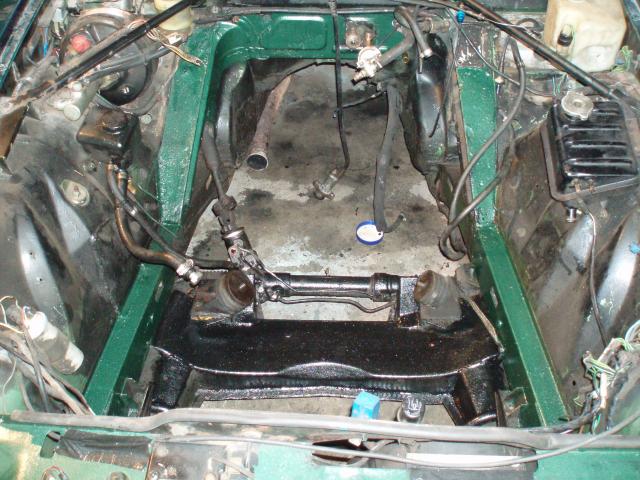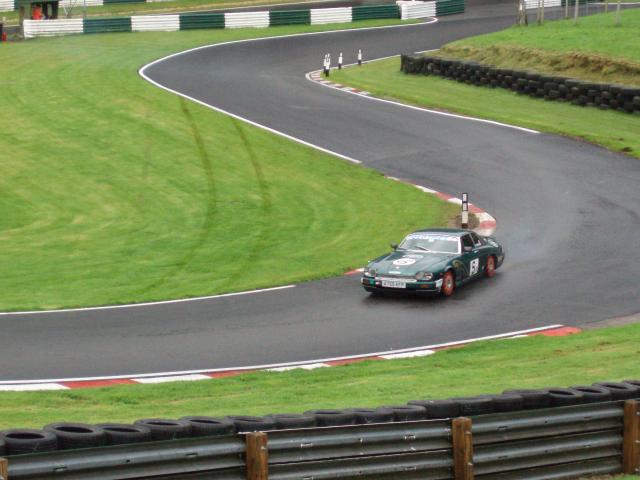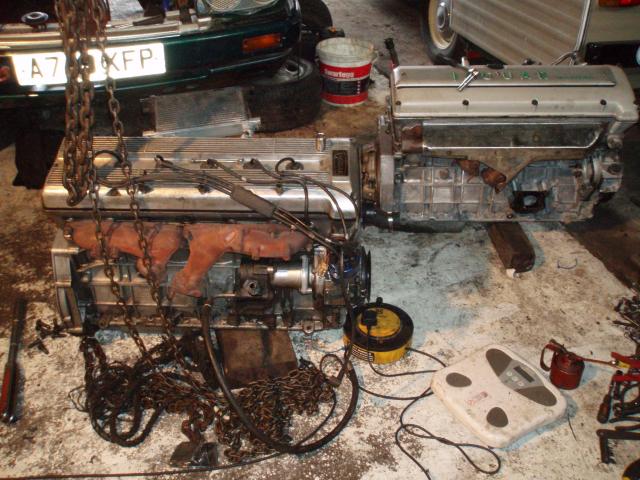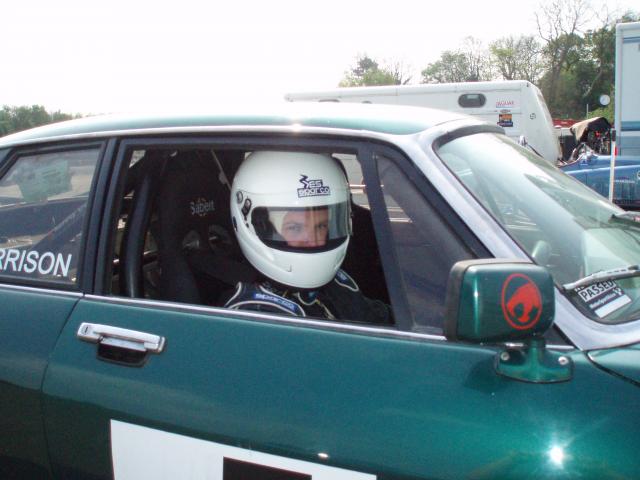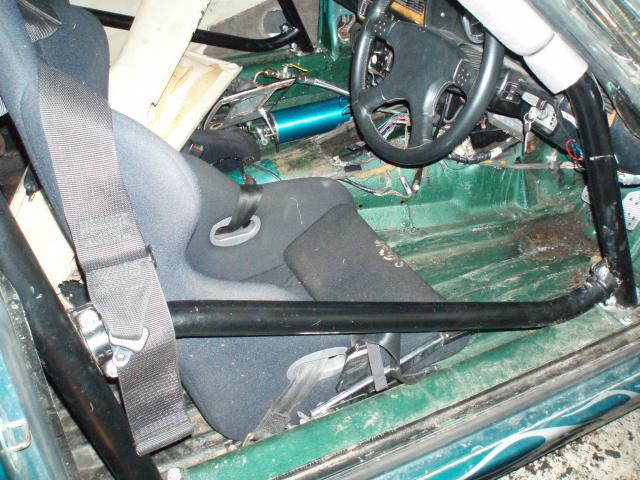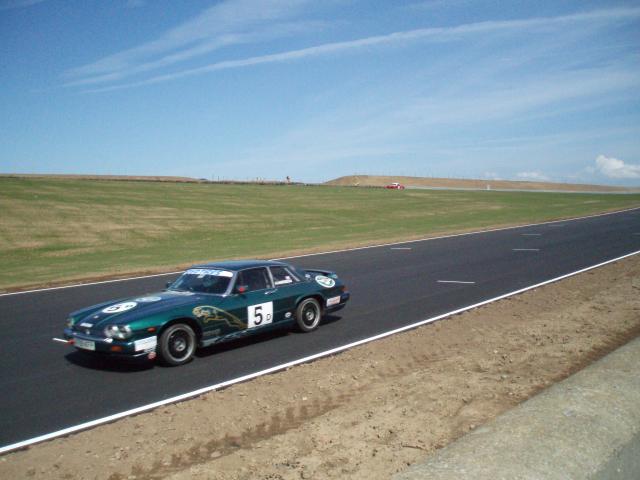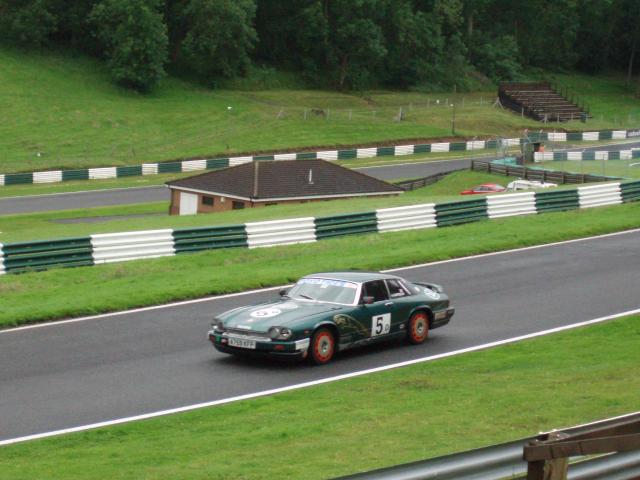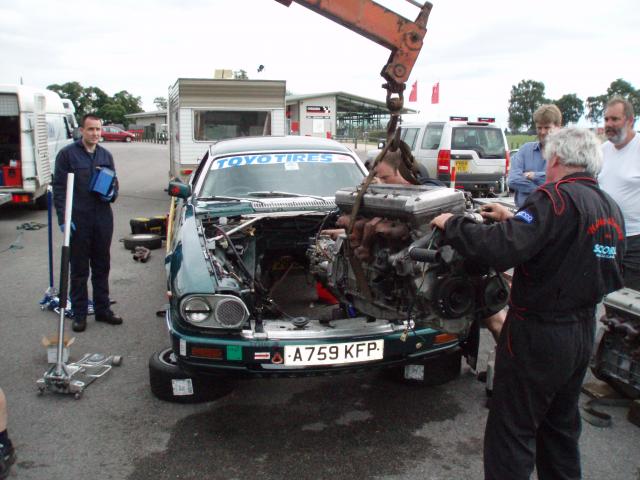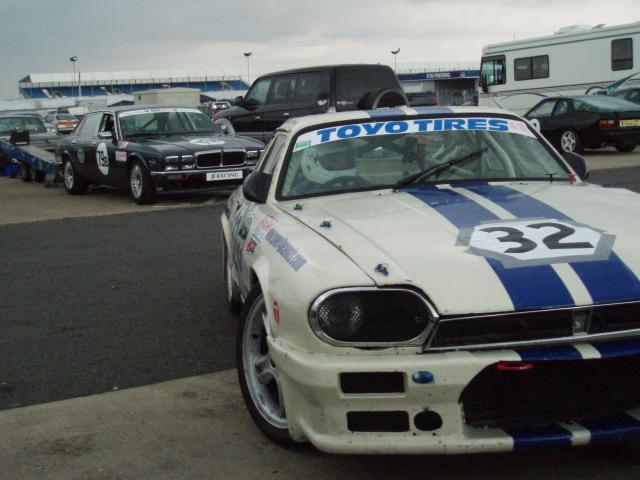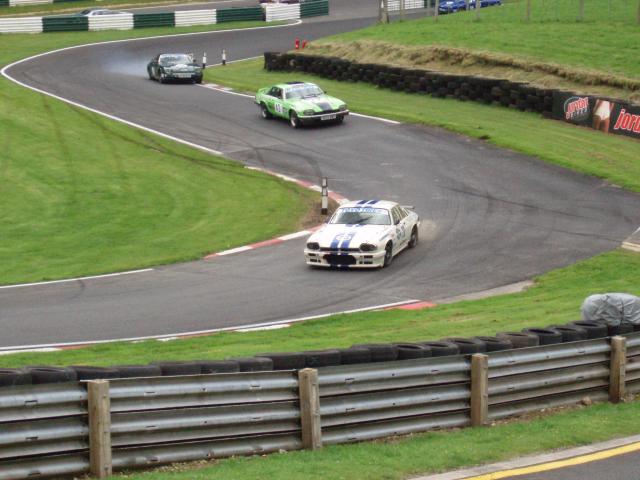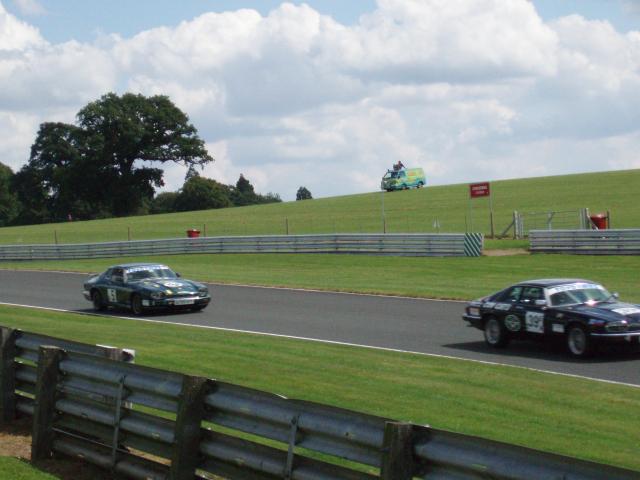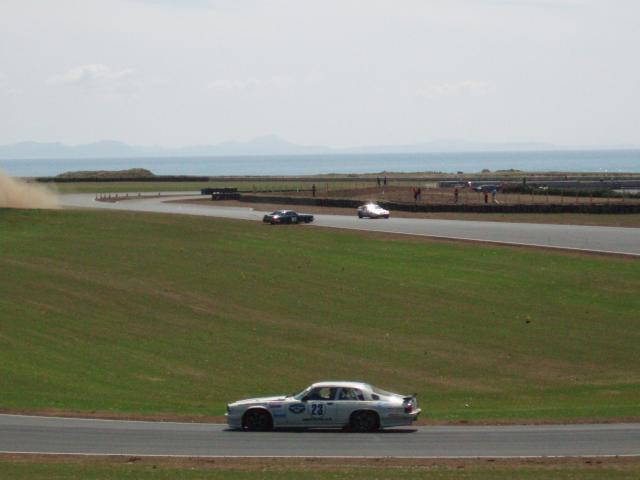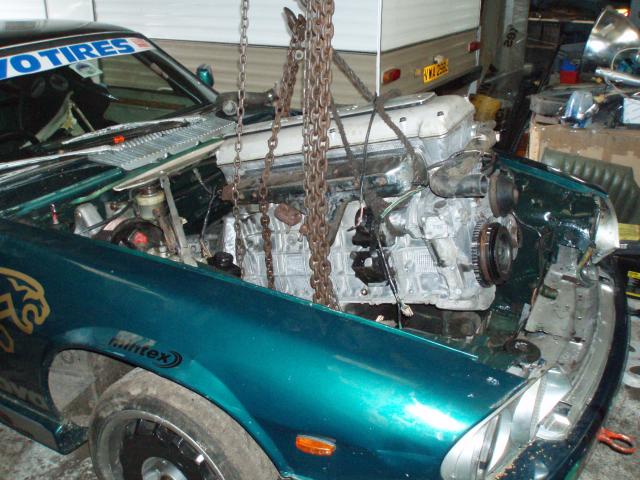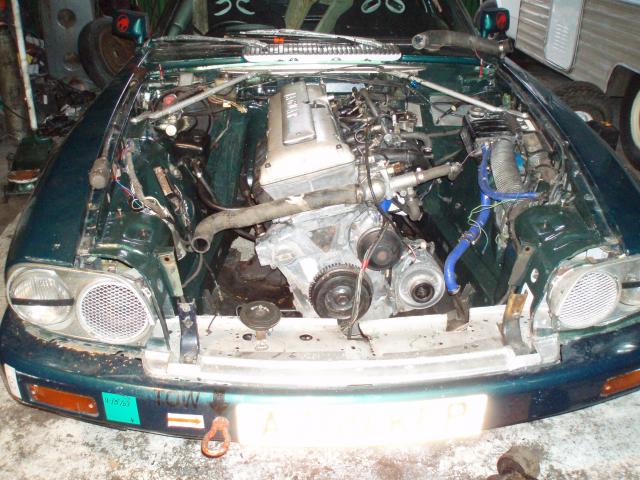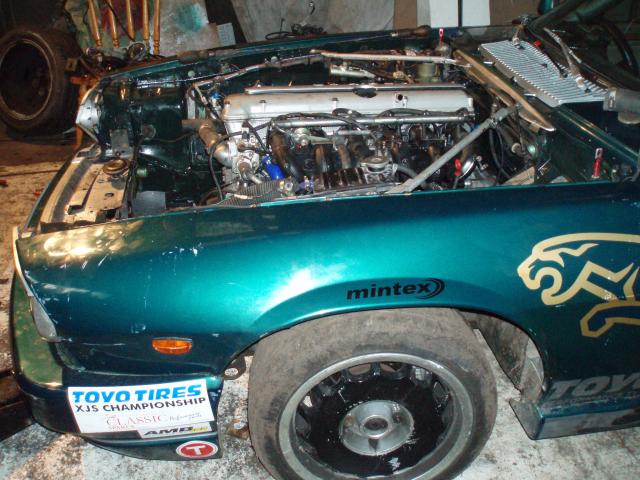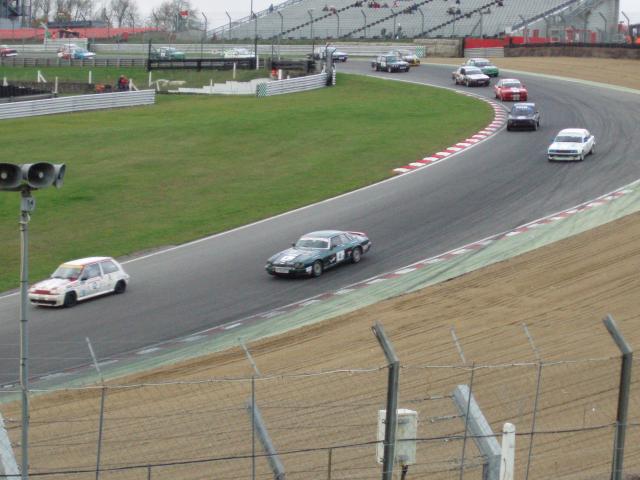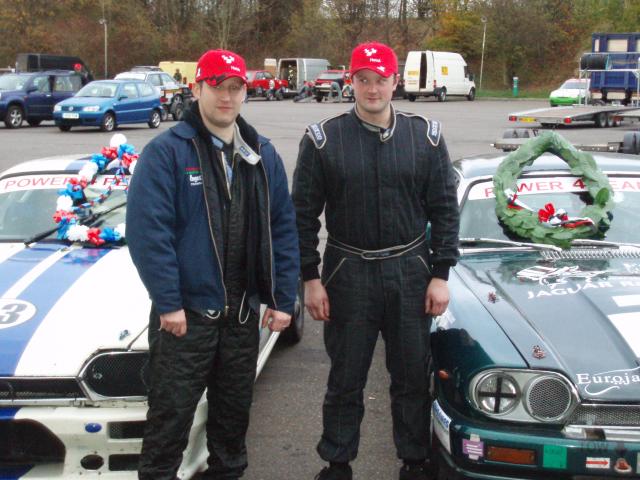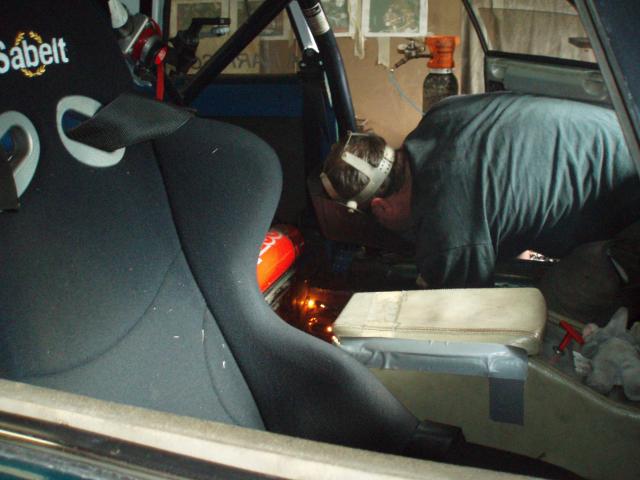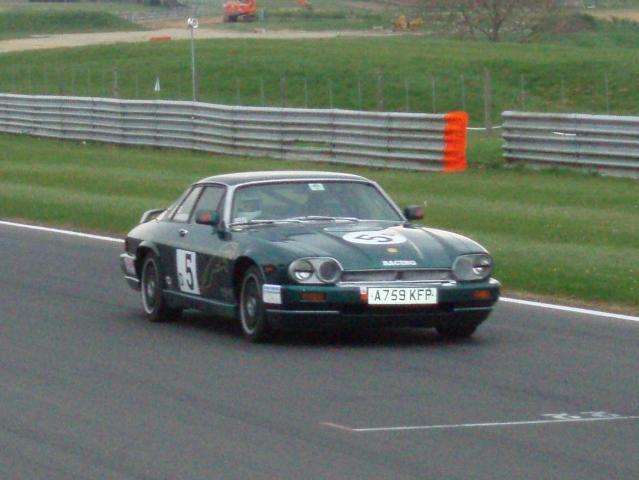- GETTING STARTED. Our guide to getting started in Jaguar racing.
I took Lock’s car out, it handled beautifully, it won the championship that year, and I utterly failed to go any faster in it than in my own car. Call it worry over breaking someone else’s car vs not giving a damn about your own, call it worry over mucking up the guy’s championship if you stuff his car, whatever, but he went a tenth quicker in my car than I did that day and I can’t blame traffic because it was the same session! Damn.
So in like-for-like conditions the other guy was quicker. Time to hang up the helmet? Nah, I’m just a novice, give me some time. It did also give me a target, something to measure myself against. The car couldn't be too far off her limits if the champion elect couldn't get her much quicker, but what if I could now make her go faster again? A target time was a godsend, and on race day I went faster again. Oh, and last thing I picked up is this: if you’re running a video camera, remember that it can hear you. Why’s that matter? Well, trust me, you don’t want to be watching the playback and hear yourself singing “we’re off to see the wizard, the wonderful wizard of Oz” in a high munchkin voice whilst waiting for the red lights, because I have the tape that proves I did, and it’s a tough one to live down.
Also recorded were "tally ho" as I set about a hot lap in quali, and later the inexplicable quoting of Meatloaf "Hang cool teddy bear" in a wet Brands race. Corrupting Def Leppard in assembly at Cadwell was clearly recorded too, I could release a greatest hits from the stuff that camera has heard me saying or singing. Remember that it can hear you. Don't threaten to kill anyone mid-race.
Cameras are handy for racing incidents, but cut both ways. Much of the time it didn't quite happen as you remember it, and they aren't as helpful as you'd like because they don't look around like you do. Helpful, but not perfect. The footage, however, is very, very helpful for analysing your own driving, you can learn from watching yourself. If you can afford one, get one
I hope some of that sorry tale helps someone avoid the many, many traps I fell into. It’s not exactly a triumph over adversity, but don’t do all the stuff I did wrong and life will be much easier.
Running in mostly this form, with some new shocks, and a paintjob for 2008, the car was essentially developed at that point, and started to win. The big changes were to reliability, and to the driver. Nothing more than that, it was a question of getting the car to work consistently, and then learning it.
If there is one overarching lesson from all the above, it is make the car reliable, then stop messing with it, just get some mileage on it and learn, because until you do you are not going to get the best out of what you have. By doing it this way you will beat the man who spent all the money but never learned the car.
After May 2008 the car and I never finished a race without winning the class, for the next 4 years. Applying the lessons of that first season are why. The photograph below was taken in 2012, with my beloved steed "Helen" at the height of her powers, lifting the front wheels at the Mountain at the country's most awe-inspiring circuit, Cadwell Park. It's race day with the Classic Touring Cars, and the grandstand behind is packed full of adoring motorsport enthusiasts.
In short, it's about as good as it gets for the club motorsport enthusiast, a great day, great weather, great track, a car working well, it's what you signed up for when you started, and why you spent so many of your (assumed) hard-earned pounds to be here. But I started racing in 2007, and I had to get started somewhere. 2007 was nothing like this. Not one bit. It was every single rookie error, ever, plus every mechanical woe you could think of. I was up before the clerk of the course in my second ever qualifying, and I got through more engines than an F1 team.
What you will find below, therefore, are two completely seperate articles I wrote back in 2008. The first details what it took and what it cost to get started in racing, the steps needed and the total bill to get me from track virgin to being sat in assembly for my first qualifying.
The second is everything that went wrong during that first season, and what I learned from each disaster. It is the "I wish I'd known X at the time" diary. It is not presented here as a definitive guide, it might not even be right, but it's what happened to me. Experienced pilots can read it with a shake of the head and a warm tingle of nostalgia, followed by a sigh of "you bloody fool."
But someone, somewhere, might benefit from my catalogue of errors. And I will end with an optimistic note. That 2007 diary might read like a comedy, but in 2008 I won a race, outright. And a championship. Then several more. Everyone has to have a first ever season.
OK, first race, it all sounds relaxed, but it’s not. As a new driver you have to do the following before the race:
The problem is usually, if you’re an XJS driver, you’re on track first, say 9 or 9.30 quali. The timetable says signing on will be say 8am, scrutineering 8.15 or 8.30, assembly 20 min before the quali. This all ignores the fact your new driver briefing is probably scheduled to clash with one or more of these and if you do it all right you need to be in two places at once even if you ignore the queues for everything.
Signing on takes 15 minutes of queuing, show your licence, collect your scrutineering ticket, easy.
Scrutineering is at least the same amount of time, probably more, and you’re late getting there because you were at the new driver briefing so you’re being called to assembly as you sit at the back of a queue of cars that are out in two hours’ time.
So, instead, do this:
That’s it, you’re in assembly, you’re on your own now. Time to find out if your £6000 was well spent.
GETTING STARTED
2007 was my first season in racing, and it was chaotic. Getting started is a confusing process, your first race is a baffling series of images that you’ll have seared into your brain for life, and at some point you’ll wish someone somewhere had told you what you were getting yourself into.
When you get started you know nothing, you know no-one, you’ve no idea what you’re doing and there’ll be moments that you’d welcome an opinion from someone that’s been there. I remember it all seeming a bit too easy, fill in this form, pass a test and off you go, how can it be that you sit one single test and then they let you drive at 140mph with a bunch of other nutters?
I had a helpful guidance from Terry Dye at JEC, but you might not be so lucky as to get the same level of help from your own race series, you might be holding the form in a trembling hand and wondering what next. If you’ve got a question, you can ask us. Contact us via the Kutuka email addresses, or phone us, we’ll answer most questions. We can also put clever and knowledgeable people in touch with you who won’t try to sell you things unless you ask them to.
What I’ve done below is set out what it took me to get started, what it cost, as far as I can remember, and the things I learned in a hurry.
I don’t claim this is a definitive guide or that I know anything anyone else doesn’t, it’s what I did, and I hope it helps someone who’s getting going or wants to start racing, whether Jaguars or otherwise, by showing how you can get some of it very wrong!
But first a warning. I can’t stress this enough. Motorsport is addictive. It’s expensive, ruinously so, but once you’ve done one single race you’ll be hooked, and you’ll never escape. Even if it ends with the car on fire in the gravel trap at the first corner you’ll be back. If you can’t afford to take up an all-consuming hobby that swallows half your waking life then don’t even look at starting, don’t think you’ll be any different and you’ll be able to treat it casually, you just can’t.
Still interested? Good.
So how do you get from bored office worker to crazed racing driver?
Step 1 is to want to go and do it. Can’t help you there, you either do or you don’t. I’d always wanted to do a bit of racing, finding out they raced XJS piqued my curiosity, because I’d got an XJS road car.
Sadly I went and bought a car before I did the rest of the job, no preparation or thought, just went and got the car and then looked into what was involved.
So I did this in rather the wrong order. Don’t do that. Before you do anything, decide what type of racing you want to do, find out the running costs, and decide if you can commit to it. Find a car for sale, just some basic asking round. Once you’ve settled on what you want to do and know what’s involved, THEN get the licence, then buy the car!
GETTING A LICENSE
Step 1 should be to get hold of a Go Racing pack from the MSA. Weblink.
It was £50 back in 2007, and what you really get out of it is the form and the blue book. And a DVD you’re meant to watch. Nowadays I believe you can just download the form but there’s one little bit hidden away in the pack that you’ve got to have and can’t download, so you have to spend the £50. Sorry.
When the Bear was getting started for ’08, we tried to avoid buying the pack, which is how we found out you can’t!
The race season starts in April, and I was starting the process a bit late, it’s February when I sent off for this pack.
Leave the blue book by the toilet, it takes ages to read…
Step 2, MEDICAL
You need an ARDS test. ARDS? Association of Racing Driver Schools. It’s your driving test for the track.
You need a medical before they’ll let you take the ARDS. You see your GP for this. Medical was £47. It depends who your GP is, mine hadn’t seen me in a decade so no deals for cash there, he had to guess the cost and he misread the licence fee as the cost of the medical! Other drivers report completely made up prices depending on who they saw and when, so the number might depend on how hard I have sued your GP lately. I do that. Sorry.
Medical’s not to too tricky, do your arms, legs and eyes work, are you dying of something that will kill you the second you get excited, and pee in this please. Very much like the checks you do when picking up a new girlfriend in fact.
ARDS
You’ll most likely be coming to racing through association with a car club of some sort, make inquiries with them whether they can help you with the ARDS at one of their track days.
I’ve already joined the JEC – about £30, and I’ve registered for the series - £70. These prices do vary, depending what you're doing, and these were only current in 2007. By way of indication, my current BARC and CTCRC memberships are £35 and £95 respectively, so expect this sort of ballpark sum.
So that was £197 so far and I’ve not yet seen a race track. It’s late February and I book in with my GP to get the medical I need. I want to do the ARDS at Mallory at the JEC track day late March, but I can’t get the medical in time and the day passes, which is a shame, because the club hold your hand through the ARDS, it works out cheaper, and it's hard as hell to fail the ARDS at Mallory.
The only place I could get an ARDS in time was Silverstone, and I find myself with a £275 half-day ARDS-only course, having forgotten to watch the DVD first. Oops.
The chief instructor is less than impressed and advises the three of us sat there, quite openly, that I’m going to fail, because this is Silverstone, they’ve got a reputation to protect and in fact that they fail a lot of people, so I’m in trouble because I’ve never been on a race track before and all I know about rear-wheel drive cars is a habit of getting the tail out on my old MGB in places I shouldn’t.
Happily the Exige I’m thrown at and the F3 driver instructor are both very forgiving and in about 45 minutes on the track I learn more about car control than in the preceding decade, and a surprise pass sends me scuttling off a happy bunny, another £47 to MSA for the license lighter.
Don’t sweat the ARDS, it’s not about going 100%, it’s more about lines and awareness, so long as you’re learning, don’t make the same error lap after lap, and you’re not a total liability then the fact you’re only at 70% pace doesn’t matter.
Generally speaking the ARDS done via the JEC track day works out cheaper and you’ll get more laps in, but I enjoyed Silverstone, and the chance for some expert tuition round the National circuit I was pretty sure would come in handy.
Different tracks have different reputations when it comes to the ARDS. Silverstone is reputed to be the hardest. There are two schools of thought with this. I liked the idea of going to the toughest and passing, because surely that sets you up better for the season ahead, but some people prefer to take the easiest possible. Prices also vary.
Look at it this way, the ARDS is easier than racing, so if you can't pass the tougher ARDS, who are you fooling? It's all very well pottering round Mallory in the instructor's diesel Astra at 35mph, but what sort of test is that? At Silverstone they were nicely blunt; it's 4 corners, if you can't master this then take up knitting. I do agree.
Having elected for the expensive ARDS then that’s £519 so far, but I’m now allowed to race.
BUYING THE CAR
A look at prices told me £5000 - £6000 would buy me a very big and very yellow 6 litre manual XJS to race. I was immediately sold on the idea, 6 litres sounds a lot, let’s have that.
That was advertised on a Jaguar racing website, the owner immediately having a heart attack at the concept of a novice driving that. He talked me out of it and into the roadgoing 3.6 and 4 litre cars. I swallow my disappointment, 4 litres is still quite a few, but my road car had 5.3 and it’s not as many as I was really hoping for.
He sent me the advert for a less scary car, and one short trip later I’d agreed to shell out £3400 for a green and gold race car, because it was just so low and racy-looking, and had lots of stickers on. 275bhp claimed, which sounded a reasonable number. I know how to buy an old car, but I know nothing about racing. The owner tells me things are a particular way, and I just accept it. Nobody goes with me, it's my own folly.
£3400 and a flash up the M1 and it was home. Of course I didn’t know then what I do now, that I was meant to cover up the race numbers in transit. Whoops. In terms of checking the car before I bought it all I’ve done is whack at the radius arm mounts, decide they’re solid, and have a peer in the cockpit. All I see there is cage and race seats and exposed wiring and no carpets, so it looks racy enough, must be fine, right?
I don’t know 6 cylinder Jags, I don’t know racing, I’ve no idea what I’m doing, I’ve just bought it. Please, if you’re going to buy a car, get involved with the club first, make friends with people and try to get a feel for their opinions on various cars before you buy. There are many racing cars for sale right now that are all in the same sort of price band, and some of them everyone will agree are value for money, and some that are horribly overpriced sheds, but if you’re getting going how do you know which is which if you don’t canvas opinions?
Best suggestion is to get yourself to one of the race meetings and get talking to people. You’ll quickly suss what you’re looking for and a look at the various standards of preparation will tell you a lot. Someone will be selling a car, you don’t have to buy the first one, there are always several out there for sale.
If you agree to buy, check what you’re getting. The sad truth is that you don’t always get all the car you saw and agreed a price for. I’ve a friend involved in another race series who can tell tales of cars sold abroad that arrive without wheels, steering wheel, or indeed an engine. We’ve all heard of cars being given an engine transplant for a standard lump in place of the tuned engine.
The only sure way to guarantee you buy the car you see is to collect it in the paddock as it comes in from its last race.
That can’t save you from the possibility that the seller has also been deceived and isn’t running the car he thinks he is, but nothing can really help you there, that’s just tough if it happens. That did happen to me.
A better look round and under the plastic side skirts means that I now weld up minor holes in the sills, repaired corrosion at top of screen pillars, and holes in the floorpan. Just because it’s an old car that races doesn’t mean it doesn’t rust like an old car.
I repaint bonnet, boot, and roof, and she’s all green now, have to do until I decide what I’m doing for my real colour scheme, and I’ve hopes at this stage that my employer’s corporate green livery might suggest itself to some sponsorship. Hopelessly optimistic, if you think you’re going to get sponsorship just by hoping you’re deluded.
I’m not very mechanically minded, I can swap the brake pads and I don’t mind throwing paint at a car, but I still have to mime which way to turn a spanner before I tackle a bolt. Boy does that change in a hurry once the season starts!
Don’t assume that a ready-done car is in fact ready. Mine blew up before I finished the first qualifying session. Pull cables go rusty, the car might have sat all winter and have grown a hole somewhere, it might have leaked all the gearbox oil away, the rules might have changed and some of the safety gear be obsolete. Seatbelts have a lifespan, check the date on them. Remember you’ve bought something someone else has finished with, they were getting rid of it for a reason, so work out what it needs doing.
Cost to date is now therefore £3969 including paint. I have a car, and a license, though if you recall I’m doing things out of order and the car and prep came before I had the licence, but you get the idea.
PRE-SEASON ALTERATIONS
Brake pads changed to Mintex race pads on advice from the series' supplier, long before the car ever saw a track. It had been run on a mix of red and yellow stuff EBC pads in the past, but discarded for Mintex and Castrol SRF race fluid added. Expensive – 2 litres and a set of pads sees little change from £200. I gulp pretty hard at the price, but I’m told that a novice driver would brake early and longer and hence wear pads and boil fluid, so I would need to pay for the good stuff.
With what I know now I’d save money on the fluid and go for the more forgiving Millers product that Dermott sells through Power4Peanuts, (see “sponsors”) as it’s cheaper, just as effective, and more tolerant, and I wouldn't use the Mintex pad, but you don’t know this sort of thing when you’re first starting, you don’t know anyone to ask. If you ask one person, you get only one option.
That’s now £4169.
Tyre profile selected, again under advice from the series' supplier. Advice was that the lower 40 profile would help a novice driver with acceleration out of corners as I wouldn’t be carrying the speed through the corners so I’d need to pull out of them better, and I’d never see the top end speeds of the faster cars in class so the lower gearing won’t hurt me. The habit of the 40s to break away with less warning wouldn’t be an issue as I won’t be going fast enough to find out. I actually found out a lot.
Again, I did as I was told. It’s not necessarily correct, but it’s the best you can do. With hindsight it was the wrong thing to do, but it got me moving.
Set of scrubbed Toyos was about £300. Why scrubbed? Well, I’m told, and it goes against my skinflint nature, that if you take your brand new high performance road tyres out there you’ll kill them in about 5 laps as the rubber just rolls off the tyre. Pre-ruin your new tyres by having them scrubbed down to 4mm before you start and they’ll last longer. Mental, isn’t it? But that’s what they all do, and I follow the crowd because what else do you do? In fact this bit turns out to be completely true, so hurrah!
Also I need wheels. It’s sitting on XJ40 type wheels, which are horrible, but I knew I was getting these when I bought it so that’s OK, and I search Ebay to pick up a set of Speedlines for £100, which in a stroke of luck puts me in touch with fellow Yorkshireman Chris – aka Buck382 – who turns out to be a stalwart of the Jaguar race series, and who will from now on prove to be an invaluable source of good and cheap spare parts, advice, news and smutty jokes.
£4569 so far.
It would be more these days, now that the Jags use proper racing tyres, which are roughly twice the price.
RACEWEAR
Now I need protective kit. I allocate £500 to saving my life. We’re off down South to pick up a trailer so stop by at GP Racewear at Silverstone. Yes, this would have been simpler when I was here to do the ARDS, but I didn't know, did I, that GPR is right there! A decent Sparco helmet swallows over half of that easily, so cheap overalls, the cheapest gloves I can get, a balaclava for extra fire protection for my pretty face, and with their discount the bill comes to a shade over.
What, no race boots? No, £10 trainers will do just fine thanks, I’m not paying that sort of money for shoes! The rules then didn’t say I have to have boots, and I don’t want them. Race boots are lovely and dainty, but my size 11s will be stuffed into trainers and I’ll just mash the pedals a bit more carefully, footwell space not such an issue as if I were in a Caterham or similar eggshell. You can't do this now, fireproof footwear is now mandatory.
What about neck protection? Should I have one of those foam donuts, or a full Hans device or what? Well, a Hans setup is lots of pennies, and I’ve not seen any club-level racer wear one. The foam donut the fella at GPR tells me is a waste of time, so no, neither.
Kit bought, I now look like a fat Power Ranger and I’m a bit concerned how the overalls appear designed to present your genitals to the world, but we’ll ignore that.
The rules these days do demand that you have proper boots, and I would recommend the balaclava to anyone, both for practicality and comfort. Easier to dry than the helmet, because you are going to sweat.
£5069, ready to race, let’s go.
TRANSPORT
One thing left then, how do I get the car there? Well, you can drive it. It’s MOT-ed and I’ve now insured and taxed it just so I have a spare car, it’s roadgoing and at this point it doesn’t look much like a racing car other than the numbers, it could just be a green XJS with gold leapers on the side, no stickers yet you see, so why not do a couple of miles in it to get used to it? Doesn’t work out that way, she does maybe 30 miles on the road before the first race. Most race cars are not roadworthy.
Insurance was weird. I’m not after race insurance, but this thing is MOT-ed, so why not try it on the road a bit and get used to the car? My insurer were great, they just added it to the road car policy for only a few pounds, because it’s not really going to get used on the road anyway. But some people can and do drive to and from the race. I didn’t fancy that, what if I crash? What if my tyres aren’t legal when I come off the circuit? Do I want to faff about changing brake pads for road-legal items just to get home?
No, got to be towed. We’ve got a camper van that will just about drag it, but a cheap and rather large heavy trailer sets me back another £500. Very wise decision. Very, very wise.
So that’s that then, 1 week til the first race and she’s ready to go. £20 of stickers for roundels and numbers, and a novice cross, and she’s en route to race 1 for the total sum of £5589. The trailer is back at my house on the Tuesday, first race is Saturday. Cutting it fine, oh yes.
SNETTERTON TEST DAY – day before first race.
Why a test day? Test days are what they say on the tin. It’s not a public track day, you must have a race license, and a race-prepped car. You can’t turn up in your boy-racer Corsa, this is for track cars. They split you up into 2 groups, open wheeled and closed, and for 45-50 minutes a session out you go to test the cars.
This being the first big test of the season for many there are lots of cars out there. Camaro to Porsche GT something Cup cars, Ferraris, Minis that are so fast it makes my eyes water, Caterhams, a bunch of Japanese-type touring cars I can’t identify, it’s busy.
We’re late, so arrive at the tail end of the first session, just get the car noise-tested and my sticker but the session’s over. Just as well, I don’t know where to go to find the track! Expect to be lost in the paddock your first time anywhere. First time getting the car off the trailer, it’s all bits of wood and ramps that stretch 30 feet across the paddock, not exactly professional.
Noise tested? Yep, ¾ max rpm and a bloke with a microphone checks you’re under 105dB. Then gives you a sticker. They do this on race day too.
I’m not even testing the car, I’m learning the track. I don’t know if the first corner goes left or right, or how fast it is, or what the hell is happening.
That first moment when you come out of the pitlane is terrifying. I’ve convinced myself in the pits that this car is greased lightning, that I am Schumacher’s undiscovered cousin, and that we’re going to set the world on fire, which was the only way to shut up the voices screaming at me that I was mental to be doing this, show the wristband to the pitlane marshall and the Jag noses out of the pits onto the track.
Sticking rigidly within my white line, nothing in the mirrors, pull out on the circuit, spot the corner, this is easy. There’s a noise like a god being castrated as the Ferrari goes down the left, then the sound of an angry baby yelling through a megaphone as the Porsche goes down the right. Half a million quid, give or take, down the sides before turn one as if I’m standing still, never saw them coming. The words I said inside the helmet were rather colourful. By the time I get to the Bomb Hole I’ve scared myself silly, I’ve seen cars come past me three at a time, and I’m convinced I’ve made a huge mistake.
First time through Coram, a Mini cocking a back wheel and leaving me for dead, and I’m thinking I must be terrible at this game, because I’ve got 4 litres and that’s just a bloody Mini, what the hell’s going on here? Dreams of a family reunion at Schloss Schumacher are fading fast.
Also learned that the new pads will do 2 laps from fresh, and then the pedal disappears, because suddenly there’s nothing underfoot and I’m straight on at turn 2. Nobody said anything about bedding them in. Touring back in it the pedal comes back half a lap later, and they’re then fine forever. Just a quirk of the pads bedding in. You need to learn how your pads behave, it’s not just stamp and hope.
By the end of the first 30 minutes out there, and firmly chanting everything my ARDS teacher told me in my head I’m going round Snett in 1 minute 40 seconds.
That’s not quick. I don’t want to be quick, I know that in 2006 the slowest car in my class was doing that time in quali, so I can now at least make the grid at the back. For the first 30 minutes on track in this car I’m happy at that. I’ve already had some wild moments though, kerbs, wide exits, bit of grass, oversteer, I’m not dialling this in as slowly as I planned, it’s getting to me and I want to push on. It is helpful to know what the laptimes last year were. You have to measure against something.
Car into the paddock for a rest, and a whole host of new experiences. The stink of hot brakes is overpowering. Now it’s like perfume to me, but at the time the smell coming off the car was enough to make me back away. The smell of hot oil, the heat of the bonnet lid as I open it to peer inside and hope it’s all still there, the sweat inside the balaclava, the car’s front spattered with bits of other people’s tyres, even the feel of the hot sun on this vast expanse of tarmac with race engines popping all over the place, it’s a series of sensations you’ve never had before.
There’s also the new phenomenon of people wanting to ask you things, ask how you’re getting on, make observations, talk about racing lines and braking points and lap times, which given your vast experience of 30 minutes is a bit bewildering.
But things start to make more sense. I ended up with Kutuka only because of pure accident, they were the only Jag there when we arrived, and not knowing my V12s from my 6s from a door stop we parked next to them to pick their brains, maybe I can follow their driver round for a couple of laps and they’ll shelter me from the big bad world. Plus they’re parked by the toilets.
Good move. Get yourself to test day, harass someone in the same type of car, find out what’s going on, where to go, what to do, have a few things explained. The Mini that’s baffling me weighs the same as my shoe and it’s on slicks, the Camaro that wandered off is packing a million horsepower, it’s not all as horrible as you think. My road tyres are not full-on racing tyres like I think, the Toyo TR1s are not selected for their soft, sticky compound, I’m not driving the F1 slicks I think.
The spares I’m carrying are jammed in biscuit tins, carrier bags, or thrown in the car. I’m even carrying a spare grill because I put mesh in mine and the rules I read seem a bit strict, and I don’t want to be barred for having sullied the XJS appearance. That’s put out of my mind when I see the Kutuka car, which has a shark’s mouth of a front end and looks like someone mated an XJS with an alien spaceship, while inside it’s a saddle strapped to an engine and makes my gleaming wood trim seem a bit silly.
Out for session 2 and now I know where the corners are it gets better. I even overtake some people on the straight bits. From there it gets better, I do 30 minute runs, take a breather, then a 10 minute dash. By lunchtime it’s a 1.34 and we’ll be higher up the theoretical grid, getting much happier.
You’ve got to remember that if you’re new to racing you’ve got no idea if you can drive competitively or not until you get out there and have a go. Not a quick squirt round a car park somewhere, but put in a competition car on track and sent to play for long enough to get used to the car and find your own limits. You’ll not get that on a four lap fling in a Ferrari on one of those Red Letter days, or even on an ARDS test, this is different. So for me the day was establishing if I had a hope of driving at all or if I’d wasted all that money. I don’t think until you’ve tried you know if you can.
By day’s end the time’s a 1.30, which if I could repeat it tomorrow would put me third in class, and I can safely say that £200 is the best money I’ve ever spent on racing. I’m more confident on the track, I’ve got used to faster cars coming up, and I’ve found that if I’m mental and leave it so late I think I’m going to die I can almost hold onto a Porsche on the brakes into the Esses. And of course I’ve been off the track everywhere.
I think I went wide at the Esses four or five times, straight off trying to take the first corner at full chat, spin at the entry to Revitt, basically all bar the Bomb Hole and Coram, but I’ve learned so much about the car’s limits, and my own.
Having thrown it at the scenery I also find this really doesn’t bother me at all, I’m chattering across the grass and gravel at Christ-knows what speed sideways, but it’s nothing. The first time’s quite something, the sound of the stones on the underside, the scream of your tyres, the world rotating and the grass coming up, but it’s not that scary really, it’s quite a novelty. Probably why I did so much of it that year...
So for God’s sake, if you do nothing else before your first race, get your car to a track. If I hadn’t I’d have been so slow and so dangerous that I doubt they’d have let me on the grid.
Day over, first race tomorrow, but that was such a worthwhile experience that I can’t suggest that anyone should turn up to their first race without doing a test day first.
So, costs to first race? Throw in the test day fee, race entry, and fuel, and it’s just over £6000 by the time I’m sitting in the assembly area with all these large and scary-looking XJS waiting to go out and qualify for my first race.
And having done that test day I find I’m not scared, just raring to go!
Not cheap, but imagine how much worse if I’d gone for that yellow 6 litre, or if I’d bought the 2006 championship-winning car like one of the other novices here has shown up in and who I’m expecting to walk all over me with it.
So that’s getting going in the first place, but what about thereafter?
2007 – how not to tackle your first season:
DISASTER 1 - SNETTERTON:
Engine 1 died at Snetterton after a test day that taught a lot about car control and murdered what was left of the engine, smoking in the morning became progressively deteriorating oil pressure over the test day, eventually running the bearings on cylinders 5 and 6 and grinding to a smoky halt in qualifying, and I was home before the first race even started. 5 laps on race day and the weekend was over.
It can happen to you. Don't assume the racing gods will take pity merely because you're a novice. You can crash, catch fire, or die no matter whether you're a novice or veteran. There is no rewind button. It can go to hell in a hurry, this hobby is bloody dangerous.
I had never driven the car on track before, indeed I had only ever been on track for my ARDS, ever. I didn't know the track, the machine, or what to do, complete rookie.
That first meeting was a whirling chaos of images. Your first signing on, first scrutineering, and the discovery that what is written in the timetable is nonsense.
Lesson # 1 – if you can afford a test day, do the test day. You cannot just go racing, you learn a lot just by getting out on the track, even if you crawl round the place, but your brain cannot deal with being a complete virgin and hope to put in a performance. If I had simply showed up to this track and gone straight to qualifying I would definitely have both crashed and had a complete nervous breakdown from sheer sensory overload, it's too much. Don't kid yourself, you just can't do it. Get some time on track, any track, first.
# 2 – don’t assume that just because you bought a racing car it’s necessarily fit to race. Mine was dead when I bought it, and it also had a lot of things claimed about it that weren't true - I don't blame the seller, he too had been told a lot of big fibs. She did not, for example, have 275bhp. She had about 220, and they were poorly horses at that.
# 3 – when you first start out and before you get to know anyone in your series your evening entertainment at a race circuit is yourself. Take a book or a TV, because by God was Snetterton dull that Friday night! Put it this way, you’re sitting alone in the middle of a car park at a deserted airfield, in the dark.
# 4 – you’ll be amazed how many people you find desperately searching for fuel over the weekend. Turn up with enough to run your car for testing and all your racing, don’t rely on the circuit having fuel.
# 5 – if your race weekend ends suddenly, do go to the circuit office and beg for a refund for at least the second race. I didn’t. £275 of entry fees and I lost the lot for 5 laps of qualifying. Beg, grovel, plead, but try get some money back or a discount off the next race. It might work.
# 6 - merely because you're a novice doesn't mean that you cannot smash the car to pieces, blow it up, crash it, get crashed into, or catch fire. Everything that can happen can happen to you. You could crash at turn 1 on lap 1, and watch your car burn to a crisp, there is no period of grace in motorsport, nobody to look after you and no right of appeal.
BRANDS HATCH – DISASTER 2
New engine in for Brands Hatch a fortnight later, a stock AJ6 out of the scrapyard for the princely sum of £125. That one did Brands Hatch but let go at
# 7 – if you get a warning like this, don’t just bodge it and leave it, it wants to be fixed properly, because though that bodge held, the cooling system let go and cost me the race at the very next circuit.
Black-flagged in qualifying for a fuel spill. We don’t know even now what happened with that, but the original Jaguar plastic cap, even when taped up, the compartment stuffed with rag and the flap tank-taped round was not up to the job of keeping fuel from spilling when the tank was full.
Why black flag? Well, I’d missed the three black and orange flags, because it’s my first race proper and I didn’t know to look for them. Sounds pathetic, doesn’t it? Wait til you’re on track with 25 other XJS on a 1 minute lap, see how many
# 8 – on your first lap on any track, look for the
First collision at Brands Hatch, a little tap on the bloke I bought the car off as he moved to defend a gap I was in, followed by another lesson as he hung me out to dry at Mclaren and I went for a spin. Worse, having hit him I didn't know if I had to let him back on in front of me, I didn't know enough about racing.
#9 – a do or die move to overtake on the brakes is more likely to end in die than do.
# 10 – experienced drivers will not be overtaken by novices easily, and they know a lot more tricks than you do. You are not and never will be a top F1 pilot.
ANGLESEY
The engine was murdered in race 2. A heater hose popped, but because I was winning my class I refused to retire despite the climbing temperature, until the car started to crack up after 22 minutes of losing coolant.
But there was more to it than that too. They were longer races, 30 minutes, with a simulated driver swap halfway. Before the race it had been confused as to exactly what the rule was about that change. The preceding race was easy, switch it off, get out, get in, go. Now it was suggested there was an alternative, to just sit in the car for a minute and then go. Nobody seemed to know.
So I applied the rule from race 1, got out, got in, all excited, and peeled out of the pitlane. A
Another
The car’s been losing coolant since the start of the race, slowly, just trailing steam rather than dropping water, but enough is gone that the minute spent stationary in the pits for the stop-go without airflow and with low coolant cracks up the engine.
If the rules had been clear to me it wouldn’t have happened, the car may have survived the race, and I might have won the class, because I was in front and extending when it all happened.
# 11 – if it’s unclear, ask. The rules change in a pretty fluid way throughout some meetings, and you won’t get laughed at for clarifying the rules of the race. This mistake cost me dearly. You do not want to look back at any race and be able to say you would have won it if you’d been clear about the rules.
# 12 – check your hoses, no point leading if you can’t finish the race. That bodge from the last meeting will bite you.
# 13 – never reverse in the pit lane during a race, even if Bernie Ecclestone is dancing on your bonnet screaming “reverse.” In fairness if this is happening you’ve probably got bigger worries than a stop-go penalty.
Lesson 14 – don’t scare the
First new tyres at this meeting, the spare pair of fronts go on for race 1 because I’d flat-spotted the others so badly in testing at Brands they were virtually bald after all the testing. Not having tasted tarmac before the new tyres were horrible for the first three laps. Knowing your tyres is important.
Also learned a little humility on
Three weeks after Anglesey, and another second hand engine in for
Foolishly, having bought the car with a skimmed and ported head I had been swapping the head from block to block with expensive new gaskets and stretch bolts (£83 per engine for the two). Not only would the head later turn out to be entirely standard, no modification at all, but it was also warped and blew a head gasket after running on 4 cylinders for 5 laps of this race.
#15 – do the job properly, and don’t assume what you’ve been told is true, peoples’ memories are fallible.
Not only that, but in the run-up to Mallory I booked a morning test session there to learn the track. I had so much trouble getting the engine to run (split extra air hose!) that I never got there - £90 wasted - and whilst the car sat still the clutch master cylinder died 2 days before the race. No time to get spare parts delivered, the car goes to the circuit needing a master cylinder fitting, Covcat’s Chris Boon to the rescue with a spare, car finally mobile 11pm before race day!
#16 – make useful contacts quickly! But also, if it's all going wrong, should you commit to going to that meeting, or sit it out and fix the car properly, once and for all?
First major damage here too, a ram in the rear bumper from another car locking up in wet quali and torpedo-ing me. Surprising how little it bothered me to be honest, but the damage took some bodging and I was happy to have my dedicated brother on hand with his endless supply of patience and pop-rivets! I couldn’t afford a new fibreglass bumper, they’re lots of pennies, had to repair the old.
This was an incident that I did nothing to deserve - it can happen to you. The other driver will come to find you, and give you his excuse. It is standard practice to simply accept that excuse, no matter how impossible it is, so long as the mistake is innocent. If it is deliberate, on the other hand, it gets much more ill-tempered. You will see this a lot, there is a lot of ego on display at race meetings, the whole racing game really boils down to who can claim to have the largest penis.
CADWELL
At this point we've informally joined Kutuka, and our new team-mate Stewert had stepped in and donated an old 4 litre engine to the cause. That’s engine number 4. Again entirely standard, and smoking like a diseased chimney it nevertheless covered a full test at Cadwell and both races, leaving a smokescreen but at least finishing the races. Water temperatures were a concern but she lived.
It is however over halfway through the year and so far I’ve managed only 3 race finishes out of 7 races before this weekend. Cadwell’s double makes that a better 5 of 9, but hardly sparkling, I’ve not even ditched the novice cross yet.
However, at this meeting I learned a lot, it was chaotic, lots of incidents, red flags, a crazy meeting. But surviving it taught me a great deal, I had some great, close racing, I saw a car fly, and I had a synchronised spin down the gooseneck with a V12. And I fell hopelessly for this circuit. I think your impression of a track is formed by your first meeting there. I love Cadwell Park. I hate Mallory. I think it's clear when I decided that.
#17 – check the car over regularly. I had worn out the rear pads without noticing, and that metal on metal sound was something I simply ignored for most of the morning test. Mind you, the Bear was also using a hammer to knock the rims straight after every run, the wheels I was using were god-awful and bending with kerb contact. Some investment in proper equipment can be helpful.
#18 – a split top hose in testing, and no spare, had to beg, borrow, and steal. Carry a spare everything, at least the important hoses, but if possible a radiator.
OULTON
So to Oulton park, and big changes, including a low-mileage AJ16 engine, £200 from Eurojag with a 3-month warranty.
That’s engine number 5, if you’re counting. Swapped this one just to try and get more power. Sadly this one lasted 2 laps. No time to test it before the test day, I did one slow tour of the track to spot the corners, and by lap 2 was leaving a carpet of smoke, piston number 6 was holed.
Eurojag were great about it, it was swapped under warranty no problem, and they let me keep the scrapper too, really can’t fault them at all, I should have tested the damned thing before I set off, but I was on the last minute as I had been all season.
#19 – don’t assume a low-mileage engine that comes with a warranty is sound – there’s a reason the car it came out of was broken up in the first place.
The engine was swapped in the paddock, yes, that's right, in the paddock, and that smoky AJ6 lived to race again on race day. What’s that you say, an engine change in the paddock? Yep. You may however wonder how I managed to find such a cracking bunch of people in one spot though, as Stewert, Dermott and David all disappear under the car, Chris Boon fetches his Hiab and my long-suffering father is prevailed upon to deliver me my old engine to the circuit.
#20 – you need to have made a few friends in the paddock, but remember that it cuts both ways, so help anyone who needs it because one day it’ll be you. Anyone you can help, do so. Racing karma has to be earned.
SILVERSTONE INTERNATIONAL
That same engine took me to my first trophy at Silverstone, the £20 oil cooler by now having decided to start weeping and having to be bypassed and bodged up in the paddock, also rendering the accusump now useless too, so a backwards step or two there. But the progress here was having left the engine alone there was time to make the car work, to play with the shocks, and to get some trouble-free miles in. That did gain me a lot of speed, in fact setting the shocks found me 3 seconds and my first class podium. There is a moment at which you do start to crack it, and if you've a reliable car that comes much sooner.
#21 - stop fiddling with the bloody car, just learn to drive it. Don't be that guy, the one that every series has, the bloke who shows up with a new £5000 development piece and claiming one million horsepower, who parks the car on lap 3 of qualifying at each and every meeting. Just make what you have reliable, and get some miles under you, you can develop it next year.
#22 – second-hand parts will only last so long. You might get what you pay for. Sometimes worth paying the extra.
#23 – testing at a track that no-one else has raced at gives you an enormous advantage.
#24 – speak to the guy who’s leading the championship by a country mile and find out why. If you can talk him into a car swap for a few laps that’s brilliant, but you might want to let him suggest it! Pick his brain. Get him pissed in the bar. He might lie to you, but at least try.
#25 – experienced drivers still make mistakes, I went from 5th place to 3rd for reasons entirely unconnected with my own driving in this race, but due to other people’s mistakes. Keep it clean and tidy and you’ll benefit from other people’s mistakes, everyone’s due one or two now and then.
By now I’d discovered a loose rear wheel bearing – caught only when I got a puncture when using the car to commute to work one morning for amusement, and rebuilt the power steering rack to eradicate the leak I’d had all year. Neither are 2 minute, simple jobs, and neither were things I carry spares of. You can’t carry everything, but wheel bearings aren’t dear, don’t take much space, and you’re screwed if one goes wrong, so up to you if you carry one or not.
#26 - check the car thoroughly after each race meeting, get into the habit of examining brakes and bearings constantly. Between races even.
If you need to change pads, do so immediately you spot you need to, I learned that one the hard way when swapping them just before setting off for a meeting had the calliper start spotting fluid – a hasty seal change needed, and of course the calliper wouldn’t come off, had to use acetylene to heat the bolt to get it off!
#27 – make sure your car comes apart when you need it to. Better to find out that something’s stuck at home than in the paddock.
SILVERSTONE NATIONAL
Change again for Silverstone round 2, brand new oil cooler, and new hoses custom-made by Pirtek, which despite a full test day without incident promptly let go at scrutineering and had to have the entire assembly bypassed. Only just cleared scrutineering in time, and I went out to qualify with no petrol in the car, resulting in a mid-session refuelling and much panic.
#28 – partly reverses lesson 21, because it’s that even new parts made by professionals can be rubbish. And there’s no way to tell when they’ll let go.
#29 – have the car ready to go the night before the race, including fuel and fluids and cleaning the damned thing. Don’t expect to do anything at all the morning of the race.
#30 – get to scrutineering as early as you can, you need maximum time to correct problems found.
# 31 – if possible don’t have the driver of the car touch anything but the controls all weekend, other than perhaps his tyre pressures. Not possible if running by yourself, but if you’ve got help use it. The calmer and more focused the driver the better, particularly if he’s a novice.
#32 – carry cash to buy stuff at the track at race prices. Who could have foreseen that I’d need 8 litres of oil between scrutineering and quali? Everyone at a race meeting has cash on them, it's a cash world at the track, nobody takes plastic.
JEC season now over the car then ran the Birkett endurance race, where it performed faultlessly for its full hour stint.
#33, don’t make the guy with 2000 jobs to do set your tyre pressures. It’s your car, you’re the driver, you know what you want in them, either do it yourself or specify precisely what you want, but do not have the overworked team manager do it because he’s got enough on his plate already. Yes, try to shield the driver from as much as possible, but ultimately it’s his or her’s responsibility. Find that balance between lessons 31 and 33, and you'll have an easier life.
#34 - an endurance race is still a race, blue flags or not don’t dive out of the way of a car that’s still a dot in the mirror.
She also ran in this form for the MSVR Autumn trophy at brands, picking up a outright win for the handicap race and finally developed to a reasonably competitive level as her driver also learned a few things about corners. So in one season we went from not even making the grid, to a race win. It was a steep learning curve, but rewarding.
#35 – when you go back to a track for the second time you’ll be miles quicker than before. I was 3 seconds faster the 2nd time out at Brands, in the same season. Don’t expect to break records first time out.
#36 – tyre pressures. Some work, some don’t. Don’t try to remember, write it down somewhere. It matters. A diary of pressures, track, and conditions, will one day help you.
SWAPPING CARS.
Anything else? Well, as a miscellaneous point, what about changing cars with someone?
Remember, if you break it you buy it, so a car swap is a bit nerve-wracking, and you ought to be a bit cautious.
I had the pleasure of trying out a class G car, Stewert’s beloved Eleanor. And I struggled with it, badly. Different handling, different power, new dash to learn, new in-flight checks to carry out, new brakes, steering, rev limits, it’s all different, and difficult, when you’re hurtling at Copse at 150mph in someone else’s car you have to start to worry.
I also learned not to copy another driver's style. Trying Stewert's Copse flick span me off the road at very high speed. My own approach differed, and wasn't necessarily slower for it, just different. You need to be adaptable, but not trapped by someone else's rules.
You might pride yourself on being able to drive anything, but you really can’t. I span twice in qualifying, nearly again in the race, and watch the video of me taking the start in that beast and cringe in your seat, learning this car was nearly as difficult as that first lap out of the pits in testing back at Snetterton. And getting back into my own car afterwards was hell, the cars were so different I still can’t remember now how I’m meant to tackle Copse in a 6 cylinder.
So what about another of the same type of car? I swapped cars with John Lock, the fella who won the XJS championship that year, and runaway class winner at every racy. He let me have his car for a few laps in testing at Silverstone, and even there I found differences, not fundamental ones like the V12, but little things like the power steering sensitivity – I like to muscle my car with minimal help, whereas his was as the factory intended, I became convinced the gearchange was slightly different and panicked over finding 4th gear all the time, the tyres were different profile, and the car felt much more smooth and compliant, I didn’t want to give it back!
What about how they did in my car? Driver ego is a terrible thing. I once read that if you know the best fighter pilot in the world and it isn’t you, then you’re not a fighter pilot. The same can be said for racing drivers. So what happens if you swap cars with someone and they go quicker than you do? Well, you’re crushed, and you’ve got to find an excuse, that’s what. Fly my pretty, fly!
The correct combination of circuit, weather, car and race causes that moment that you pay all that money for. But it can go so very wrong.
This was one unfortunate customer's first ever race. Didn't go well. My first laps on track in a Jag, absolutely bewildered by what was going on, and a complete liability. There is no "grace" period for novices. A little mid-season repair was swiftly required.
This happens. A lot. All the gear, no idea.
Practising my best "I'm a racing driver" glare first time out at Brands Hatch The cockpit in those early days was a right mess. We've come a long way since then. But it all worked, and that is the important bit. Swapping engines in a hurry, after another cheap scrapyard special blew up. Sometimes you get what you pay for. The engine bay too was a bit of a joke back then. This really was bargain basement racing, buy a banger and go. The puff of oil smoke was always her trademark. Midfield at Brands, first race ever. And I wasn't last. Race 2 at Brands. Still not last. Collecting signatures in the hunt for the magic 6 that would allow the removal of the novice cross. Testing at the then-brand-new Anglesey. For that first season I tested every single track.
And still do. The dust cloud and sideways car is me exceeding the limits.
And you should. It's how you find them. Still trailing that cloud of smoke.
Tomorrow that engine will destroy itself. But some of the shots from that first season, Anglesey with the sea in the background, were worth the price of admission. Another engine, and an odd combination of wet and dry tyres at Mallory. A really, really crap meeting in every possible way. Broke that. Another engine. By this point I had lost count. Upgrades starting to creep in though - that silicone hose is a lesson learned. Testing at a damp Cadwell, and beginning what I can only call an obsession with the place. Nothing like it. In opposite lock at the cafe at Cadwell on race day. It's subtle, but it's there. Might be learning a bit by now. And a damp Cadwell test you can almost have to yourself.
Which is actually kind of nice. Qualifying at Caddy.
Still towing that smoke cloud behind her, but loving it. Racing at Cadwell, and because I'd tested, top 10 finish despite my inexperience. Testing pays big dividends. The scuff marks all over the front wing are from Cadwell's bollards. I have never, ever, been there and not run a couple over. Engine transplant in the paddock at Oulton Park, as we formally become a member of the nutter of Kutuka Motorsport. Racing hard at Oulton after the trackside engine swap. Never, ever, ever give up. Tenacity will yield results. Smoking my way to that first magic trophy, 3rd in class at Silverstone on a day to remember. Yet another engine, now that there was a little time to play with. The more reliable car would now see her first win. Silverstone National, end of that first season.
One thing I did learn here was that not all drivers obey yellow flags. Heading out in Stewert Lyddall's "Eleanor" to try my hand at a V12.
They are a lot of fun. I span this one. Twice. Enjoying the mixed grid of the inaugural "Victor Meldrew" handicap race that gave birth to the TTRS series. I was the first ever winner. Season end, and enjoying the fruits of victory.
It's a long, long way from where the year began. You can't rehearse your victory speech for the Range Rover podium if you don't know you've won.
I had no idea.



